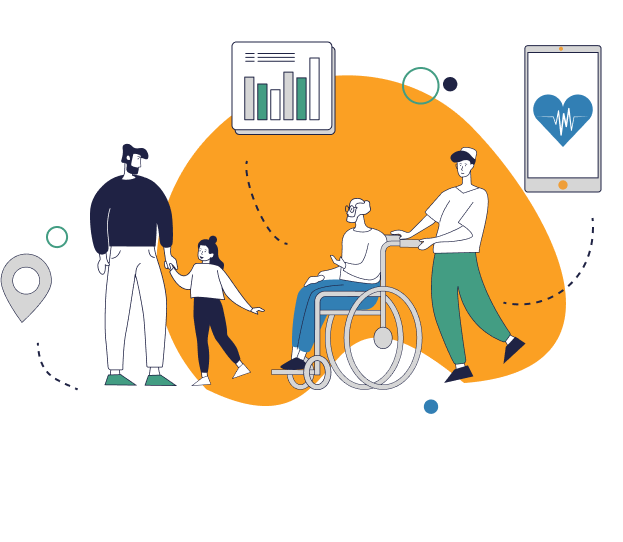The social and medico-social sector
Do you have a project to create an innovative digital social and/or medico-social tool? Consult our services to understand, prepare and anticipate.

Find out more about the sector to help you design your innovations!
Project Manager, Agence du Numérique en Sante (Digital Health Agency)
A word from Elsa Creac'h
The social and medico-social sector is distinguished by its diversity(over 40,000 structures, with very different activities, serving the elderly, people with disabilities, people in precarious situations etc.) and its heterogeneity(size of structures, internal organization, IS maturity...). Despite a difficult economic context, innovations abound to favor aging well, prevent loss of autonomy, compensate for disability, facilitate the daily work of professionals...We therefore wanted, through this G_NIUS service, to highlight this sector, and provide some keys to understanding for entrepreneurs innovating in favor of users and professionals in the sector.
The medical-social sector
What is the medico-social and social sector?
Combining health and social services, the medico-social and social sector offers a wide range of services for the care and/or support of individuals in situations of precariousness, exclusion, disability or dependency. The medico-social and social sector is constantly evolving, adapting to society's changing needs and advances in the health and social fields.
Medical-social and social establishments and services
Facilities
Medical-social and social facilities offer a variety of services. They include retirement homes, facilities for people with disabilities, rehabilitation centers, and many more. Each facility is designed to provide tailored care and personalized support, with an emphasis on residents' quality of life. In addition, health care facilities play a crucial role in ensuring appropriate medical care.
Services
The services provided are not limited to physical facilities. They also include in-home services, mobile response teams, and care coordination platforms. They ensure continuity of care and regular support for those who need it. In-home services are particularly important for people wishing to remain in their familiar surroundings while receiving appropriate care. Coordination platforms play an essential role in centralizing information and facilitating communication between the various players in the sector.
Professionals and professions in the medical-social and social sector
Professionals
Medical-social and social professionals are key players in the implementation of services in this sector. They include nurses, care assistants, social workers, psychologists, and other specialists. The training of these professionals is essential to guarantee quality services. Ongoing training programs are often offered to ensure that professionals' skills are up to date and in tune with new practices and requirements in the sector. What's more, these training courses enable professionals to better understand changes in public policy and societal expectations, thus ensuring an appropriate response to users' needs.
The professions
Medical-social and social professions are diverse, covering a wide range of skills and specialties. Among the most common professions are:
- Caregiver: Provides basic care and daily support to patients.
- Nurse: Provides medical care and accompanies patients on their health journey.
- Social worker: Helps individuals and families overcome social and economic difficulty.
- Specialized educator: Works with children and adults in difficulty to promote their social integration and autonomy.
Medico-social and health establishments require close coordination between different professions to ensure comprehensive and coherent support for users. Professionals need to work together to respond effectively to the needs of those in their care. This cooperation is facilitated by the use of shared medical records and regular coordination meetings. There are several modes of financing for these innovative medico-social and social solutions.
Action by the State and social players
How are medico-social and social public policies implemented?
The action of the State is decisive in the development and support of the medico-social and social activity line. Public policies and regulations are put in place by actors in the medico-social and social sector to finance establishments and guarantee access to care for all. Social players, such as associations and non-governmental organizations, also play a crucial role in complementing government action. They provide innovative solutions and local support for the most vulnerable populations. What's more, these social actors are often at the forefront of initiatives to promote the inclusion and empowerment of people in vulnerable situations.
The challenges
Many medico-social and social challenges
The medico-social sector is facing a number of challenges, including an aging population, an increase in chronic diseases, and the need to adapt services to the specific needs of people with disabilities. To meet these challenges, coordination between the various players must be seamless, and this is made possible by new technological solutions. For example, digital platforms enable better care management and personalized patient follow-up.
Innovation, a response to face medico-social and social challenges
Digital transformation, enables better care coordination and easier access to medical information. Health and medico-social establishments are increasingly investing in innovative technologies to improve the quality of the services they offer. This integrated approach is essential to meet the sector's current and future challenges. Technological innovations include the use of telemedicine, which enables remote consultations, and home monitoring tools, which help monitor patients' health in real time.
In summary
This sector guarantees quality support and care for people in vulnerable situations. Thanks to the commitment of professionals and the support of public policies, it continues to adapt and meet the needs of the population. Ongoing training and innovation are essential levers for ensuring the efficiency and sustainability of medico-social services. In addition, the involvement of social players and the adoption of advanced technologies strengthen the sector's ability to offer personalized care and respond rapidly to emerging challenges. The medico-social sector is therefore well positioned to continue evolving and providing essential services to those who need them most.
Health and social actions focus not only on the treatment of disease, but also on prevention and psychological support. Services include awareness and education programs to encourage healthy lifestyles. Facilities are also involved in research and innovation to improve healthcare practices and outcomes. Social services encompass community support initiatives, rehabilitation programs, and vocational reintegration efforts, ensuring a holistic approach to individual well-being.
Social and health policies also promote greater inclusion of people with disabilities, ensuring that every facility and service is accessible and suitable for all. Players in the sector must therefore remain vigilant and innovative to respond effectively to the growing and diverse needs of the population, while supporting the ongoing training of their professionals and adopting new technologies to improve the quality of care and services.

